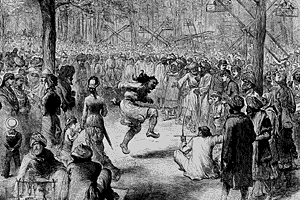| THE SEEPEE FAIR, SIMLA |
| "About seven miles from Simla, in a forest of magnifcent deodar trees, stands a small solitary temple, the shrine of an idol of diminutive size, but of great sanctity. Once a year, early in May, this pretty but lonely spot becomes the centre of a most animated and lively scene. The natives, from all the neighbouring districts of the Himalayas, flock to the Seepee temple in their newest clothes and most fanciful jewellery, partly to pay their respects to the little doll of a god, for whose service numerous coppers are showered into his collection plate, but more generally to take part in the business and pleasure of the fair. |
| "The hill tribes are poor, and the steep slopes they cultivate are incapable of affording support to more than a limited population, unless, indeed, the ground were tilled with more industry than its owners possess. To reduce numbers, polyandry is resorted to, taking the form of all the brothers in one family having but one wife in common. Numbers of the men leave their villages in summer and find lucrative employment as jhampan or litter-bearers, and in other load carrying work in the large hill-stations frequented by Europeans; but there is no employment for women, and Seepee supplies the necessary thinning process to their numbers. |
| "The main business of Seepee Fair, then, is the sales of the superfluous female population, though but little of the bartering meets the eye of a European. There, ready for sale, on the great day of the fair, are seen hundreds of gaudily but nonetheless somewhat tastefully and pretty women, loaded with jewellery, seated, closely packed, in irregular rows, on the steep side of the hill among the deodars, chattering, laughing, and talking, for the most part apparently quite careless as to their fate. And there are the dealers, forcing their way between the two rows, looking them over. There, too, are European ladies and gentlemen, from Simla, who vie with the dealers in staring the hill maidens out of countenance, even bargaining for and examining the jewels they wear. |
| "On this great day, however, the business of wife selling is slack, and quotations of prices are difficult to obtain, varying from 120 to 200 rs. [Rupees], the principal sales being effected, it is said, on the following day. But on this occasion the humours of the fair and its pleasures are more prominent. |
| "All around the most open and level part of the forest whirl hundreds of merry-go-rounds, of the rudest and apparently most insecure construction, each carrying four small boxes or cradles, containing men and women cramped into attitudes which seem to European eyes exceedingly uncomfortable. But this seems to afford much amusement and gratification to the natives, for as long as their money lasts they treat themselves and their women-kind to the rough jolting process. At one side are numbers of small stalls loaded with sham jewellery, the greater part of which comes from Birmingham. Here are large kettle-drums, the proprietors of which derive a considerable income from the love of natives for tomtom performances; and they charge a few coppers to strangers for the privilege of beating away till the performer is tired, There are temporary kitchens, whence proceed most uninviting odours, and where enormous quantities of somewhat greasy looking sweetmeats are bought and eaten; while in the centre some native Rajah spends his money on exhibitions of nautch girls, and a variety of hill sports. |
| "One of the most amusing of these is a novel exhibition or archery. Archers step out one by one to shoot at a man having his legs protected by tight fitting leather gaiters, who dances about in front of the bowmen, and two or three yards only from them. The contortions of the man shot at are amusing, and, judging by the number of misses, it would seem either that the archers are very indifferent shots, or that the aim was not so easy as it looked, for the gaiters were but seldom hit. The extremely bright dresses of the natives, contrasting with the sombre forest, make a scene which is not easily described or forgotten. It is impossible to do justice to it in pen and ink. A visit to Seepee fair is worth a very long day's journey." |
| "We are indebted to Major J.M. Richardson, R.A. [Royal Artillery], for this escription, and for the Sketch that we have engraved." |

